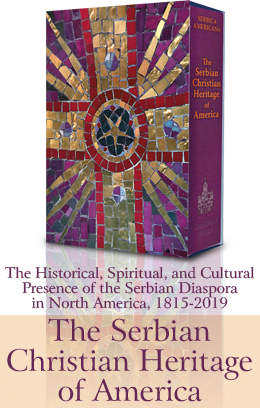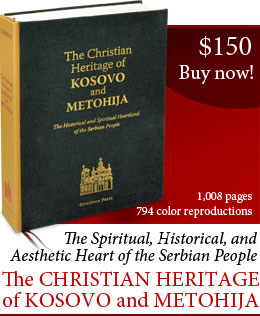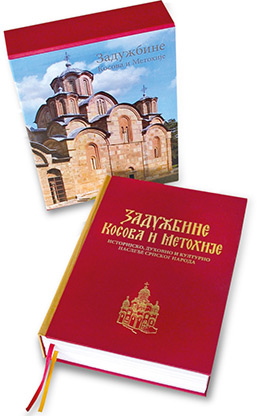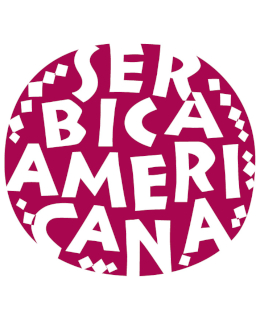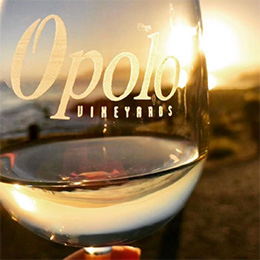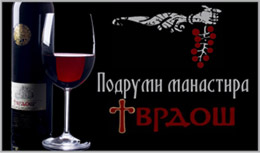ADDENDA
HOLY SERBS (Dates of Feast days according to the new – Gregorian – calendar)
Avakum, Avaccum, venerable – deacon (30th December)
Anastasija, Anastasia, venerable – Ana, St. Sava’s Mother (6th July)
Angelina, venerable – despotess (12th August, 23rd December)
Arsenije Sremac, Arsenius (Arsenye) of Srem, saint – archbishop (10th November)
Vasilije Ostroski Cudotvorac, Basil of Ostrog the Wonderworker, saint – bishop (12th May)
Visarion Saraj, Bissarion Saray, venerable (3rd November)
Vladislav (Stefan Vladislav), holy, king (7th October)
Gavrilo Lesnovski, Gabriel of Lesnovo, venerable (28th January)
Gavril I, Gabriel I, heromartyr – patriarch (26th December)
Grigorije Molcalnik, Gregory the Silent, venerable (20th December)
Grigorije, Gregory, saint – bishop of Raska (Rashka) (12th September)
David, venerable – Dimitrije Nemanjic (Dimitriye Nemanyich) – knez (7th October)
Danilo II, Daniel II, saint – archbishop (2nd January)
Dragutin, holy – king (see Teoktist)
Djordje, George – despot (see Maksim)
Djordje Kratovac, George of Kratovo, saint new-martyr (24th February, 8th June)
Zosim Tumanski, Zosima of Tuman, (see Sinaiti)
Jakov, Jacob, saint – archbishop (16th February)
Jevgenija, Eugenia, (see Jefrosinija, Euphrosenia)
Jevstatije I, Eustace I, saint – archbishop (17th January)
Jevstatije II, Eustace II, saint – archbishop (29th August)
Jelena Decanska, (Yellena) Helen of Decani (Dechani), venerable (3rd June)
Jelena, Helen, saint – queen (12th November)
Jelisaveta, (Yellisaveta) Elisabeth, venerable – Jelena Stiljanovic (Yellena Shtiliyanovich) (17th October)
Jefrem, (Yephrem) Ephraem, saint – patriarch (28th June)
Jefrosinija, (Yephrosynia) Euphrosyne, venerable – Milica (Militsa) (1st August)
Jeftimije Decanski, (Yephtimiye Dechanski) Euphtimius of Decani, venerable (24th November)
Joakim Osogovski, Joachim of Osogovo, venerable (29th August)
Joanikije Devicki, Joannicius of Devic (Devitch) venerable (7th May, 15th December)
Joanikije, Joannicius, saint – patriarch (16th September)
Joasaf srpski Meteorita, Joasaph of Serbia the Meteorite, venerable – the last of Nemanjic Dynasthy (3th May)
Jov, Job (see Sinaiti)
Jovan Vladimir, John Vladimir, holy – king of Zeta (4th June)
Jovan Novi (Brankovic), John the New Brankovich), holy – despot (23th December)
Josif Novi, Joseph the New, saint (28th September)
Kirilo, Cyril, saint – patriarch (12th September)
Maksim, Maxim, saint – archbishop – Djordje Brankovic, despot – (31th January)
Martirije, Martyrius (see Sinaiti)
Milica, see Jefrosinija
Milutin, holy – king (12th November)
Nemanja, (see Simeon Mirotocivi)
Nestor Decanski, Nestor of Dechani, venerable (4th November)
Nestor, (see Sinaiti)
Nikodim, Nikodemus, saint – archbishop (24th May)
Nikodim Tismanski, Nikodemos of Tisman, venerable (8th January)
Nikon, saint – patriarch (12th September)
Petar Koriski, Peter of Korish, saint (18th June)
Petar Cetinjski Cudotvorac, Peter of Cetinje (Cetinye) the Wonder-Worker, saint (31th October)
Prohor Pcinjski, Prochorus of Pcinja (Pchinya), venerable (1th November)
Roman, Romanus, (see Sinaiti)
Romil Ravanicki, Romilus of Ravanica (Ravanitsa), (see Sinaites)
Rafailo Banatski Hilandarac, Raphael of Banat the Hilandarian, venerable (29th August)
Sava I, saint – archbishop (27th January)
Sava II, saint – archbishop (21th January)
Sava II Brankovic (Brankovich), saint – metropolitan (7th May)
Sava III, saint – archbishop (8th August)
Simeon Mirotocivi, Simeon the Myrovlyte, saint – Stefan Nemanja (Nemanya) (26th February)
Simon monah, Simon the Monk, venerable – king, Stefan Prvovencani (Prvovenchany – The First Crowned) (7th October)
Sinaiti, Sinaites, venerable (19th May)
Sisoj, Syssoes, (see Sinaiti)
Spiridon, Spyridon, saint – patriarch (28th June)
Stefan Decanski, Stephan of Dechani, saint – Stefan Uros (Urosh) III, king (24th November)
Stefan Lazarevic, Stephan Lazarevich, saint – despot (11th August)
Stefan Nemanja, (see Simeon Mirotocivi)
Stefan Piperski, Stephan of Piperi, venerable (2th June)
Stefan Prvovencan (Stephen the Firstcrowned)i, (see Simon monah)
Stefan Slepi, Stephen the Blind, despot (22th October)
Stefan Uros (Urosh), saint – emperor (15th December)
Stefan Urosic Nemanjic (Uroshits Nemanyich), saint – knez (24th November)
Stefan Stiljanovic (Shtilyanovich), saint – knez (17th October)
Teodor Komogovinski, Theodore of Komogovo, holy martyr
Teoktist, Theoctist, venerable – Dragutin, king (12th October)
SERBIAN RULERS
Holy King Jovan (John) Vladimir (992-1016) is the first known king of Zeta. In 998 Emperor Samuilo (Samuel) took him prisoner. Jovan eventually married Samuilo’s daughter Kosara and was installed King of Zeta. He was treacherously murdered in Prespa in 1016 by Samuilo’s nephew Vladislav. He was canonized saint. His biography was published in “Letopis Popa Dukljanina” (“Chronicles of a Priest of Doclea”). Feast day, 4th June.
NEMANJICI (NEMANYICH DYNASTY)
Stefan Nemanja (Stephan Nemanya) / Sveti Simeon Mirotocivi (St. Symeon the Myrovlyte) – Grand Zupan of Raska 1168-1196 – preserved independence of Raska. Had three sons: Vukan (ruler of Zeta), Stefan (ruler of Raska) and Rastko who became monk Sava. Stefan Nemanja abdicated in 1196 and took monastic vows as monk Simeon on Mount Athos. Together with St. Sava he established monastery Hilandar. He also founded monasteries Studenica (Studenitsa), Djurdjevi Stupovi (Pillars of St. George), churches of the Holy Theotokos and St. Nicholas in Kursumlija (Kurshumlia). Feast day, 26th February.
King Stefan Prvovencani [(Stephen Prvovenchany) (Stephen the First-Crowned)] / St. Simon monah (St. Simon the Monk) – Grand Zupan of Raska (1196-1217), king (1217-1227). Successful in defending Raska both from internal and external dangers. He was aided by his brother, monk Sava, who reconciled discorded brethren by brining St. Simeon’s relics from Hilandar to Serbia. With skilful diplomacy he overcame temptation of Latin rule in Constantinople. In 1219 he created an independent Serbian Archbishopric in monastery Zica (Zhicha) and became first Serbian ruler to be crowned king (in 1220 in Zica). He died as monk Simon. His relics are resting in monastery Studenica. Feast day, 7th October.
King Radoslav, 1227-1233 – Eldest son of King Stefan Prvovencani.
King Vladislav, 1234-1243 – Another son of King Stefan Prvovencani. He built monastery Mileseva (Milesheva) near Prepolje (Prepolye) where St. Sava’s relics were laid to rest after being brought from Bulgaria. Feast day, 7th October.
King Uros I (Urosh), 1243-1276 – Another son of King Stefan Prvovencani. He married a French princess – Helen of Anjou. The period of his rule was marked by a major development of mining industry and coin making. He died in 1280 and was entombed in his memorial church – monastery Sopocani (Sopochany) near Novi Pazar.
King Dragutin / monah Teoktist (Theoctist the Monk), - Son of King Uros I. He removed his father from the throne and ruled independently from 1276. At the Council of Dezevo (Dezhevo) he abdicated in favour of his brother Milutin, but kept the north and northeast regions of Serbia as his own domain. He died in 1316 and was entombed in monastery Djurdjevi Stupovi (Pillars of St. George) near Novi Pazar. Feast day, 12th October.
King Milutin, 1282-1321 – Son of King Uros I. Through almost constant warfare against Byzantium and Hungary he succeeded in greatly enlarging Serbian territory. His rule was also marked with great cultural, spiritual and economic prosperity in Serbia. He founded numerous monasteries and churches both in Serbia and abroad: Gracanica (Grachanitsa), Banjska (Banyska), Nagoricane (Nagorichane) etc. Feast day, 12th November.
King Stefan Decanski (Stephen of Dechani), 1321-1331 – Son of King Milutin. He beat Bulgarians at the battle of Velbuzd (Velbuzhd) in 1330 and initiated construction of monastery Decani. Came into conflict with his son Dusan (Dushan) and died suddenly in 1331. He was entombed in monastery Decani. Feast day, 24th November.
Emperor Dusan (Dushan), king 1331-1346, emperor 1346-1355 – Son of King Stefan Decanski. Renowned as an excellent military leader in wars with Byzantium and Bulgarians. He increased Serbian territory at the expense of neighbouring Byzantium and proved to be the most powerful ruler in the region. During his rule Serbian Church was elevated to the level of a Patriarchate, its See being monastery Pec (Pech). Dusan was crowned the first Serbian Emperor (1346) in Skoplje (Skoplye). He was responsible for important Legislation introduced at the Council of Skoplje (1349) and at the Council of Ser (1354). He planned military action against Ottoman Turks, but died unexpectedly in 1355. His body was laid in his mausoleum church – monastery of the Holy Archangels near Prizren, which has since been destroyed by Turks. His body now rests in St. Mark’s church in Beograd.
Emperor Uros I Nemanjic (Urosh I Nemanyich), 1355-1371 – Emperor Dusan’s son. Last ruler of Nemanjic dynasty. During his rule regional lords gained independence from central authority: Balsici (Balshichi), Mrnjavcevici (Mrnyavchevichi), Vojinovici (Voinovichi), Dejanovici (Deyanovichi), Altomanovici (Altomanovichi) … He was nicknamed “Nejaki” (“The Frail”) for his lack of ruling energy. He died in 1371 after the battle of Marica (Maritsa) was fought. Feast day, 15th December.
King Vukasin Mrnjavcevic (Vukashin Mrnyavchevich), ruled as King (1365) over: Prizren, Skoplje, Prilep and Ohrid. He was the official co-ruler to the Emperor Uros. Turks killed both him and his brother Ugljesa (Uglyesha) at the battle of Marica in 1371.
King Marko Mrnjavcevic, (1335-1395) – King Vukasin’s son. After succeeding his father’s title and domains he paid tribute to the Turks. He died in the battle of Rovine in 1395. He is the most popular character of Serbian folk poetry – depicted as Marko Kraljevic (Kralyevic), always a hero – brave, mighty and handsome.
Knez Lazar / Hrebeljanovic (Hrebelyanovich) / (Sv. Car Lazar) (Holy Emperor Lazar), - Knez 1371-1389. Ruled regions of Pomoravlje (Pomoravlye) and Rudnik. Exerted efforts to reunite Serbian lands and offered most resistance to the Turkish penetration of Balkans and Europe in general. He was killed in the battle of Kosovo 28th/15th June 1389 (Vidovdan – Feast day of St. Vitus). His relics rest in monastery Ravanica (Ravanitsa). He erected monastery Ravanica, Lazarica (Lazarytsa), Gornjak (Gornyak) …
Despot Stefan Lazarevic (Stephan Larazevich), 1389-1427 – Knez Lazar’s son and heir. Ruled as Turkish tributary aided by his mother Milica (Militsa). After battle of Angora (1402) he became an independent ruler and a Despot, receiving Macva (Machva) and Beograd from Hungarians. He was a poet and a knight. Serbia made a general recovery under his rule. He erected monastery Manasija (Manasya)/Resava near Despotovac (Despotovats). Feast day, 1th August.
Despot Djuradj Brankovic (George Brankovich), 1427-1456 – Son of Vuk Brankovic, grandson to Knez Lazar. Built the fortress of Smederevo, the last Serbian stronghold. He ruled during very difficult times of Turkish peril.
King Tvrtko I Kotromanic (Kotromanych), (1338-1391) – Bosnian Ban (1353-1377) and King (1377-1391). He succeeded his uncle Ban Stefan Kotromanic. He fought Hungarians with success. He was related to the Nemanjic dynasty through female line of descent (grandson of Jelisaveta) – Yellisaveta, Elisabeth, daughter of King Dragutin). He was crowned King in 1377 in monastery Mileseva. He ruled the Littoral, Zahumlje (Zahumlye), Dalmatia and the whole of Bosnia.
King Stefan Vukcic Kosaca (Stephan Vukchich Kosacha), 1448-1466 – Carried title of “Herceg od Sv. Save” (Herzeg of St. Sava). He was one of the last Serbian independent rulers of Herzegovina before the fall of the region under Turkish rule.
King Stepan Tomasevic (Tomashevich), 1461-1466 – Last Bosnian king. Turks killed him in 1463 and this caused the final downfall of medieval Bosnia under Turkish rule.
PETROVIC (PETROVICH) DYNASTY OF MONTENEGRO
Bishop Danilo (Daniel), 1670-1735 – Ordained by Patrairch Arsenius III Carnojevic (Charnoyevich). Purged converts to Islam in Montenegro. First to establish links with Russia. Bishops’ title becomes hereditary.
Bishop Vasilije (Basil), 1700-1766 – Spent time in Russia on three different occasions. This antagonised both the Venetians and the Turks against him. He wrote “History of Montenegro”, its first history ever to be written.
Bishop St. Petar I (Peter), 1747-1830 – Metropolitan from 1782-1830. Fought both the Turks and the French. He initiated first written legislation in Montenegro (1796 and 1803). He reconciled feuding families (clans) and put an end to feuding in general. Feast day, 31th October.
Bishop Petar II, Njegos (Peter II, Nyegosh), 1813-1851 – One of the most renowned bards of Serbian poetry; educated, talented and wise. Ruled during very difficult times. He founded schools and publishing houses. Died young at the age of 38. Wrote: Luca Mikrokozma (Lucha Mycrocosma, The Light of Micro-Cosmos), Gorski Vijenac (Gorsky Vyenats, Montanin Wreath), Lazni Car Scepan Mali (The False Emperor Schepan Maly) …
Knez Danilo Petrovic (Daniel Petrovich), (1826-1860) – Knez (1851-1860); heir to Bishop P. Njegos. Initiated State Legislation; helped rebels in Herzegovina against Turks. He fought Omer Pasha Latas in 1852 and defeated Turks near Grabnovo in 1858. Assassinated in Kotor in 1860.
Knez and King Nikola Petrovic (Nicholas), 1848-1921 – Knez (1860-1910) and King (1910-1918). His was the longest rule in Montenegro; aided Bosnian rebels in 1875. Montenegro internationally recognised as independent in 1876. After victory over Turks (1881-82), aided rebellion in Herzegovina. Ally of Serbia during Balkan Wars. Died in Italy in 1921. His body is resting in Cetinje. Renowned for his patriotic poetry.
OBRENOVIC (OBRENOVICH) DYNASTY
Knez Milos (Mylosh) (1780-1860) – Knez 1815-1839 and 1858-1860; leader of the Second popular revolt of 1815; a very skilful diplomat. Turks officially agreed in 1830 to recognise him as Knez of Serbia with hereditary rights. He leaned towards autocratic rule and owing to such an inclination he was forced to leave Serbia in 1839. From 1841-1858 Serbia was ruled by Knez Aleksandr Karadjordjevic (Alexandar Karagyorgyevich). Milos returned to Serbia in 1858. He was a renowned builder and restorer of churches and monasteries of Serbia.
Knez Milan, 1839 – Older son of Knez Milos. Being a very sickly person he ruled for less than one year and died in 1839.
Knez Mihailo Obrenovic (Mihaylo, Michael), (1823-1868) – Knez 1839-1842 and 1860-1868; second son of Knez Milos. Took refuge in Austria after a rebellion against him in Serbia. Returned in 1860. He organized a people’s army and had it equipped. In 1862 Turks shelled Beograd and that action on their part caused a popular backlash which forced them to leave towns of Serbia in 1867. He made great preparations for gaining full independence from Turks, but was suddenly assassinated in 1868.
Knez and King Milan, (1854-1901) – Nephrew to Knez Milos (his brother Jefrem’s [Ephraem] son). He received the title of Knez in 1872 at the age of 18 and fought wars against Turks to free South Serbia. He was particularly successfully 1878-8 and in 1882 he proclaimed himself King of Serbia. He also fought a war against Bulgaria in 1885 which resulted in a defeat and which brought great diplomatic harm to Serbia. He abdicated 1889-1893 and died in Vienna in 1901. He was buried in monastery Krusedol (Krushedol).
King Aleksandr, (1876-1903) – King Milan’s son; King from 1893-1903. Came to the throne through a coup. He lacked popularity among ordinary folk owing to his liaison to Draga Masin (Mashin) and to his strange behaviour. He was assassinated in a military plot in 1903, thus becoming the last Obrenovic dynasty ruler of Serbia.
KARADJORDJEVIC (KARAGYORGYEVICH) DYNASTY
Djordje Petrovic, Karadjordje (Gyorgye Petrovich, Black George), (1768-1817) – Initiated Karadjordjevic Dynasty as rulers. He was a trader, insurgent against Turks, member of Serbian militia in the Austrian army, and leader of the First Serbian Revolt against Turks in 1804. He was a brave and a relentless man. After the revolt was crushed in 1813 he emigrated to Russia via Austria. He returned to Serbia in 1817 but was assassinated on the orders of Knez Milos (13th July 1817). His body rests at Oplenac (Oplenats) – Karadjordjevic Dynasty mausoleum.
Knez Aleksandr Karadjordjevic, (1806-1885) – Karadjordje’s son and Knez of Serbia 1842-1858. He was educated in Russia. A Civil Law was introduced during his rule its author being his Minister Garasanin (Garashanyn).
King Petar I (Peter I), (1844-1921) – Karadjordje’s grandson, King of Serbia (1903) and King of Serbs, Croats and Slovenes until 1921. He was educated in Switzerland and France. As Petar Mrkonjic (Mrkonyich), King Petar took part in Bosnia and Herzegovina rebellions in 1875. Although very old he personally took part in Balkan and First World Wars. He was renowned as a great democrat and was very much loved by his ordinary subjects.
King Aleksandr I, (1888-1934) – King Petar’s youngest son; official heir to the throne since 1909; Regent 1914-1918; Regent of Jugoslavija (Yugoslavia) 1918-1921; King 1921-1934. For being an active participant in Balkan and First World War became nicknamed “Knightly King – the Unifier”. He was assassinated in Marseilles, France 9th October 1934.
Petar II, - King of Jugoslavija 1941-1945; son of King Aleksandr I; became king through a military coup 27th March 1941. After Germany attacked Jugoslavija he took refuge along with the Jugoslav Government in London – Great Britain. Communist authorities did not allow his return to the country after the war had ended. He died in 1970.
Aleksandr (1945), - Heir-apparent to the throne of Jugoslavija.
Petar (1980), - Eldest son of the Heir-apparent
SERBIAN ARCHBISHOPS AND PATRIARCHS
(Hierarchichal Succession of the Patriarchal See of Serbia)
ARCHBISHOPS
1. Sava I (Sveti Sava, Saint Sava), 1219-1233 (+1236)
2. Arsenije I Sremac (Arsenius I of Srem), 1233-1263 (+1266)
3. Sava II, 1263-1271
4. Danilo I (Daniel I), 1271-1272
5. Joanikije I (Joannicius I), 1272-1276 (+1279)
6. Jevstatije I (Eustatius I), 1279-1286
7. Jakov (Jakob), 1286-1292
8. Jevstatije II (Eustatius II), 1292-1309
9. Sava III, 1309-1316
10. Nikodim (Nikodemus), 1317-1324
11. Danilo II (Daniel II), 1324-1337
PATRIARCHS
1. Joanikije II (Joannicius II), 1338-1346-1354
2. Sava IV, 1354-1357
3. Jefrem (Ephraem), 1375-1380 and 1389-1390
4. Spiridon (Spirydon), 1380-1389
5. Danilo III (Daniel III), 1391-1396
6. Sava V, 1396-1409
7. Kirilo (Cyril), 1409-1418
8. Nikon, 1418 to sometime after 1435
9. Nikodim II (Nikodemus II), 1445-1455 (?)
10. Arsenije II (Arsenius II), 1457-1463
11. Jovan (John), archbishop … 1508 …
12. Marko (Mark), metropolitan … 1524 …
13. Pavle (Paul), metropolitan of Smederevo, 1527-1535 (?)
14. Makarije (Macarius), 1557-1571 (+1574)
15. Antonije (Anthony), 1571-1575
16. Gerasim (Gerasiums), 1575-1586
17. Savatije (Sabbatios), 1587
18. Jerotej (Hieroteos), 1589-1590
19. Filip (Philip), 1591-1592
20. Jovan (John), 1592-1613
21. Pajsije (Paisius), 1615-1648
22. Gavrilo (Gabriel), 1648-1655 (+1659)
23. Maksim (Maxim), 1655-1674 (+1680)
24. Arsenije III (Arsenius III), 1674-1690 (+1706)
25. Kalinik I, 1691-1710
26. Atanasije I (Athanasius I), 1711-1712
27. Mojsije (Moses), 1712-1726
28. Arsenije IV (Arsenius IV), 1726-1737 (+1748)
29. Joanikije III (Joannicius III), 1739-1746
30. Atanasije II (Athanasius II), 1746 – 1752
31. Gavrilo II (Gabriel II), 1752
32. Gavrilo III (Gabriel III), 1755
33. Vikentije Stefanovic (Vicentius Stefanovich)
34. Pajsije II (Paisius II)
35. Gavrilo IV (Gabriel IV)
36. Kirilo (Cyril), 1758-1763
37. Vasilije (Basil), 1763-1765 (+1772)
38. Kalinik II, 1765-1766
39. Dimitrije (Dimitrius), 1920-1930
40. Varnava (Barnabas), 1930-1937
41. Gavrilo (Gabriel), 1938-1950
42. Vikentije (Vicentius), 1950-1958
43. German (Herman), 1958-1990 (+1991)
44. Pavle (Paul), 1990-2009







